Understanding the Research Process
VerifiedAdded on 2023/06/10
|9
|1893
|105
AI Summary
This article discusses the research process, including literature review, analysis of qualitative and quantitative data, alternative research strategies, and initial research ideas related to safety, health, and environment.
Contribute Materials
Your contribution can guide someone’s learning journey. Share your
documents today.
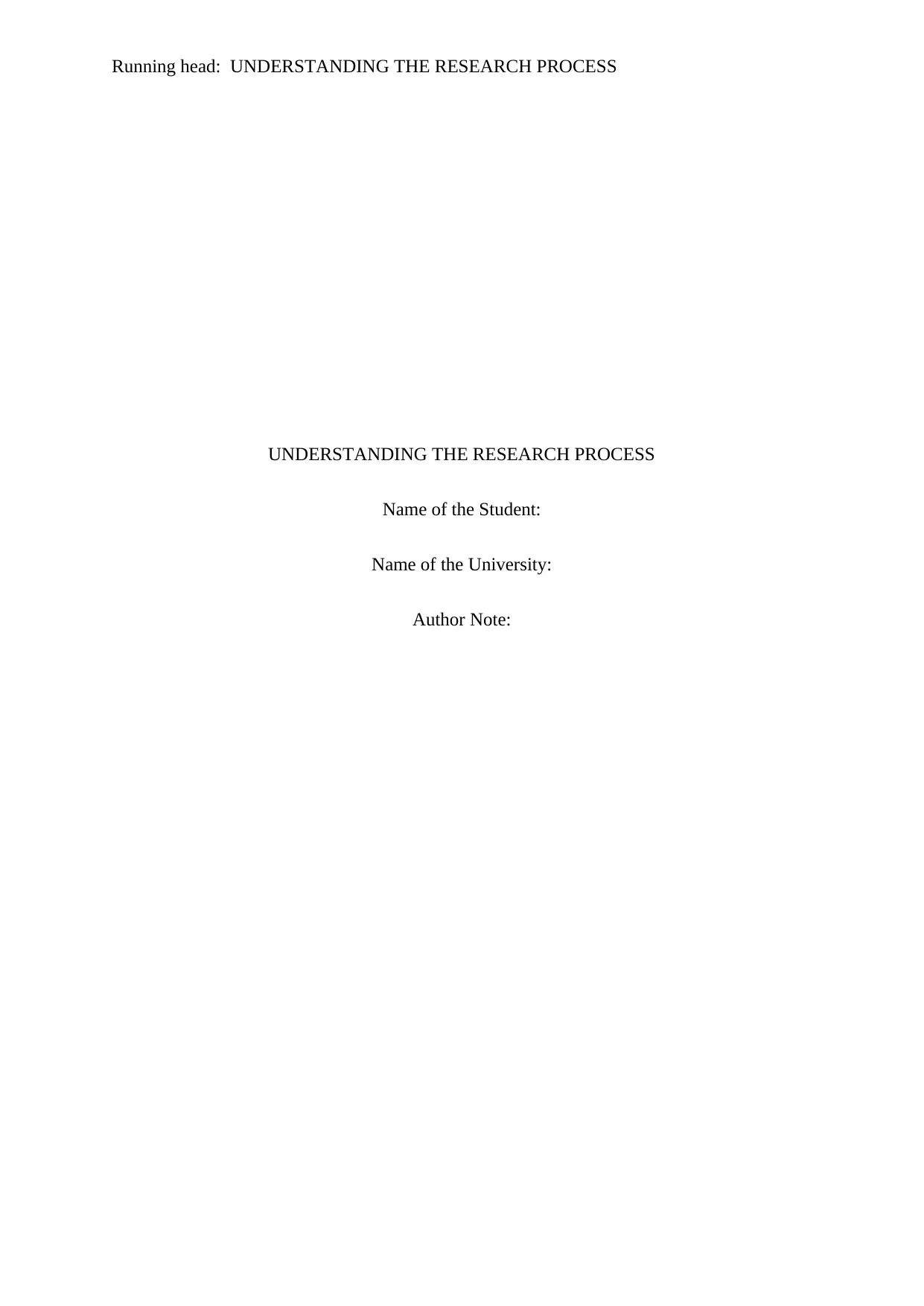
Running head: UNDERSTANDING THE RESEARCH PROCESS
UNDERSTANDING THE RESEARCH PROCESS
Name of the Student:
Name of the University:
Author Note:
UNDERSTANDING THE RESEARCH PROCESS
Name of the Student:
Name of the University:
Author Note:
Secure Best Marks with AI Grader
Need help grading? Try our AI Grader for instant feedback on your assignments.
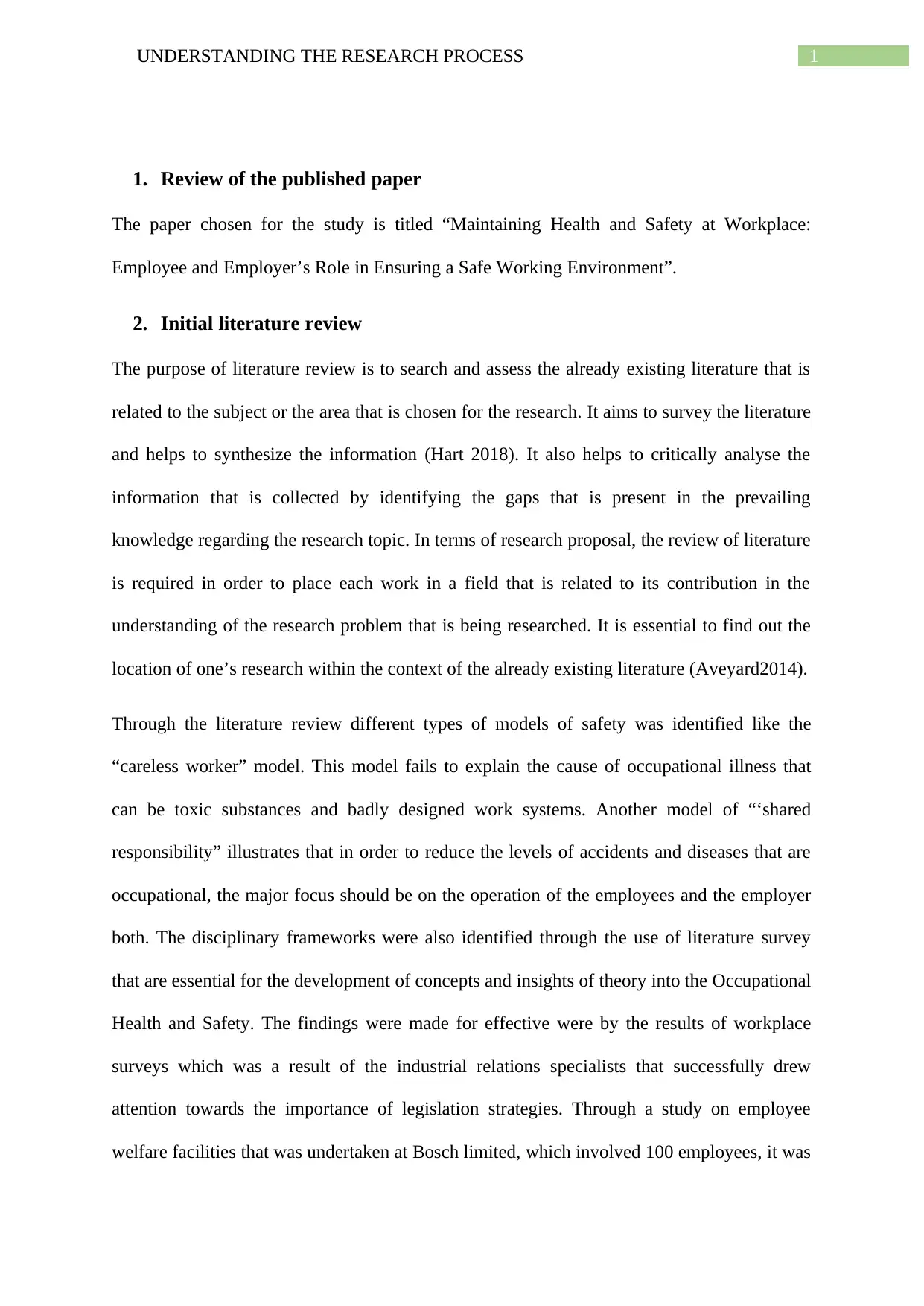
1UNDERSTANDING THE RESEARCH PROCESS
1. Review of the published paper
The paper chosen for the study is titled “Maintaining Health and Safety at Workplace:
Employee and Employer’s Role in Ensuring a Safe Working Environment”.
2. Initial literature review
The purpose of literature review is to search and assess the already existing literature that is
related to the subject or the area that is chosen for the research. It aims to survey the literature
and helps to synthesize the information (Hart 2018). It also helps to critically analyse the
information that is collected by identifying the gaps that is present in the prevailing
knowledge regarding the research topic. In terms of research proposal, the review of literature
is required in order to place each work in a field that is related to its contribution in the
understanding of the research problem that is being researched. It is essential to find out the
location of one’s research within the context of the already existing literature (Aveyard2014).
Through the literature review different types of models of safety was identified like the
“careless worker” model. This model fails to explain the cause of occupational illness that
can be toxic substances and badly designed work systems. Another model of “‘shared
responsibility” illustrates that in order to reduce the levels of accidents and diseases that are
occupational, the major focus should be on the operation of the employees and the employer
both. The disciplinary frameworks were also identified through the use of literature survey
that are essential for the development of concepts and insights of theory into the Occupational
Health and Safety. The findings were made for effective were by the results of workplace
surveys which was a result of the industrial relations specialists that successfully drew
attention towards the importance of legislation strategies. Through a study on employee
welfare facilities that was undertaken at Bosch limited, which involved 100 employees, it was
1. Review of the published paper
The paper chosen for the study is titled “Maintaining Health and Safety at Workplace:
Employee and Employer’s Role in Ensuring a Safe Working Environment”.
2. Initial literature review
The purpose of literature review is to search and assess the already existing literature that is
related to the subject or the area that is chosen for the research. It aims to survey the literature
and helps to synthesize the information (Hart 2018). It also helps to critically analyse the
information that is collected by identifying the gaps that is present in the prevailing
knowledge regarding the research topic. In terms of research proposal, the review of literature
is required in order to place each work in a field that is related to its contribution in the
understanding of the research problem that is being researched. It is essential to find out the
location of one’s research within the context of the already existing literature (Aveyard2014).
Through the literature review different types of models of safety was identified like the
“careless worker” model. This model fails to explain the cause of occupational illness that
can be toxic substances and badly designed work systems. Another model of “‘shared
responsibility” illustrates that in order to reduce the levels of accidents and diseases that are
occupational, the major focus should be on the operation of the employees and the employer
both. The disciplinary frameworks were also identified through the use of literature survey
that are essential for the development of concepts and insights of theory into the Occupational
Health and Safety. The findings were made for effective were by the results of workplace
surveys which was a result of the industrial relations specialists that successfully drew
attention towards the importance of legislation strategies. Through a study on employee
welfare facilities that was undertaken at Bosch limited, which involved 100 employees, it was
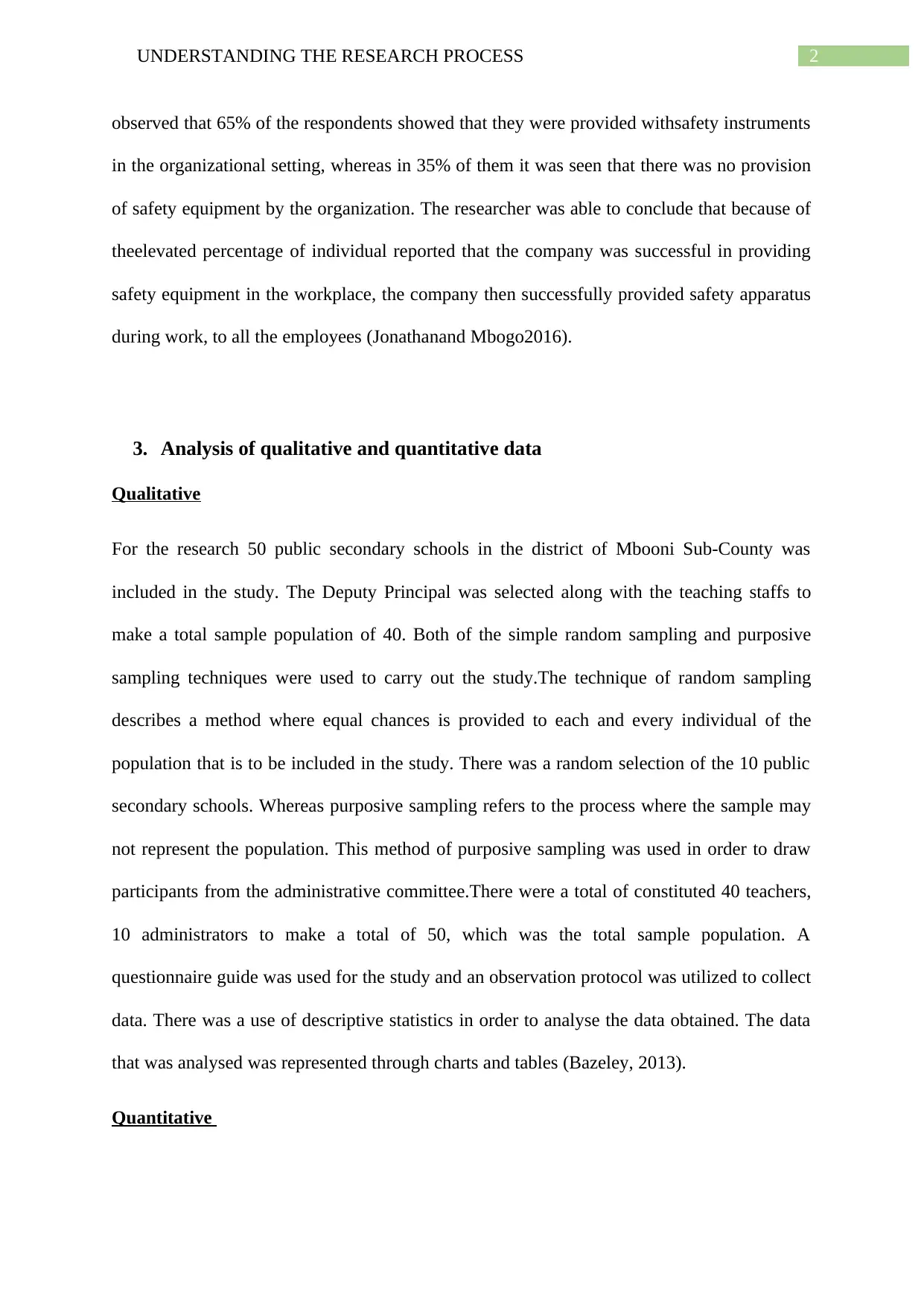
2UNDERSTANDING THE RESEARCH PROCESS
observed that 65% of the respondents showed that they were provided withsafety instruments
in the organizational setting, whereas in 35% of them it was seen that there was no provision
of safety equipment by the organization. The researcher was able to conclude that because of
theelevated percentage of individual reported that the company was successful in providing
safety equipment in the workplace, the company then successfully provided safety apparatus
during work, to all the employees (Jonathanand Mbogo2016).
3. Analysis of qualitative and quantitative data
Qualitative
For the research 50 public secondary schools in the district of Mbooni Sub-County was
included in the study. The Deputy Principal was selected along with the teaching staffs to
make a total sample population of 40. Both of the simple random sampling and purposive
sampling techniques were used to carry out the study.The technique of random sampling
describes a method where equal chances is provided to each and every individual of the
population that is to be included in the study. There was a random selection of the 10 public
secondary schools. Whereas purposive sampling refers to the process where the sample may
not represent the population. This method of purposive sampling was used in order to draw
participants from the administrative committee.There were a total of constituted 40 teachers,
10 administrators to make a total of 50, which was the total sample population. A
questionnaire guide was used for the study and an observation protocol was utilized to collect
data. There was a use of descriptive statistics in order to analyse the data obtained. The data
that was analysed was represented through charts and tables (Bazeley, 2013).
Quantitative
observed that 65% of the respondents showed that they were provided withsafety instruments
in the organizational setting, whereas in 35% of them it was seen that there was no provision
of safety equipment by the organization. The researcher was able to conclude that because of
theelevated percentage of individual reported that the company was successful in providing
safety equipment in the workplace, the company then successfully provided safety apparatus
during work, to all the employees (Jonathanand Mbogo2016).
3. Analysis of qualitative and quantitative data
Qualitative
For the research 50 public secondary schools in the district of Mbooni Sub-County was
included in the study. The Deputy Principal was selected along with the teaching staffs to
make a total sample population of 40. Both of the simple random sampling and purposive
sampling techniques were used to carry out the study.The technique of random sampling
describes a method where equal chances is provided to each and every individual of the
population that is to be included in the study. There was a random selection of the 10 public
secondary schools. Whereas purposive sampling refers to the process where the sample may
not represent the population. This method of purposive sampling was used in order to draw
participants from the administrative committee.There were a total of constituted 40 teachers,
10 administrators to make a total of 50, which was the total sample population. A
questionnaire guide was used for the study and an observation protocol was utilized to collect
data. There was a use of descriptive statistics in order to analyse the data obtained. The data
that was analysed was represented through charts and tables (Bazeley, 2013).
Quantitative
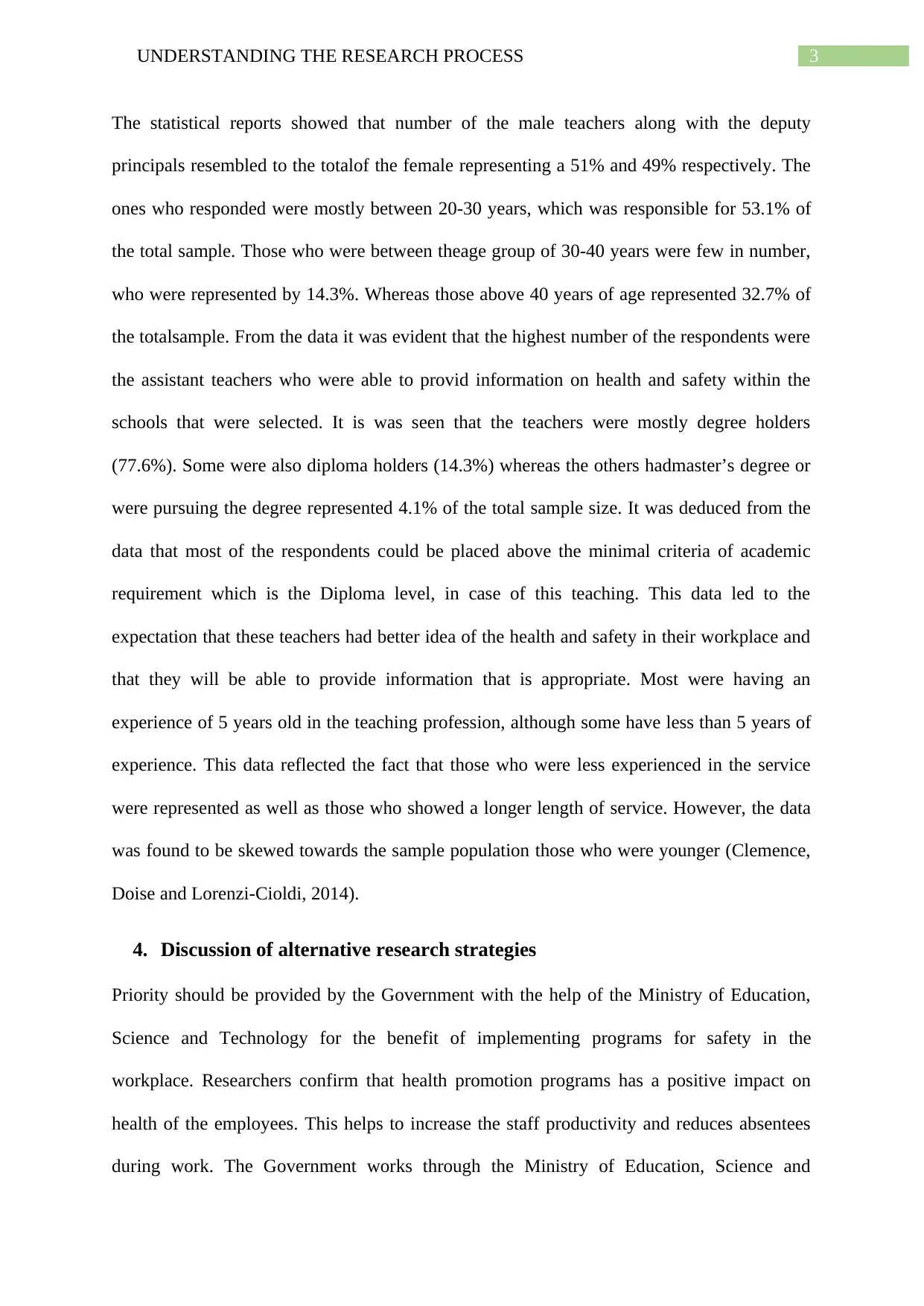
3UNDERSTANDING THE RESEARCH PROCESS
The statistical reports showed that number of the male teachers along with the deputy
principals resembled to the totalof the female representing a 51% and 49% respectively. The
ones who responded were mostly between 20-30 years, which was responsible for 53.1% of
the total sample. Those who were between theage group of 30-40 years were few in number,
who were represented by 14.3%. Whereas those above 40 years of age represented 32.7% of
the totalsample. From the data it was evident that the highest number of the respondents were
the assistant teachers who were able to provid information on health and safety within the
schools that were selected. It is was seen that the teachers were mostly degree holders
(77.6%). Some were also diploma holders (14.3%) whereas the others hadmaster’s degree or
were pursuing the degree represented 4.1% of the total sample size. It was deduced from the
data that most of the respondents could be placed above the minimal criteria of academic
requirement which is the Diploma level, in case of this teaching. This data led to the
expectation that these teachers had better idea of the health and safety in their workplace and
that they will be able to provide information that is appropriate. Most were having an
experience of 5 years old in the teaching profession, although some have less than 5 years of
experience. This data reflected the fact that those who were less experienced in the service
were represented as well as those who showed a longer length of service. However, the data
was found to be skewed towards the sample population those who were younger (Clemence,
Doise and Lorenzi-Cioldi, 2014).
4. Discussion of alternative research strategies
Priority should be provided by the Government with the help of the Ministry of Education,
Science and Technology for the benefit of implementing programs for safety in the
workplace. Researchers confirm that health promotion programs has a positive impact on
health of the employees. This helps to increase the staff productivity and reduces absentees
during work. The Government works through the Ministry of Education, Science and
The statistical reports showed that number of the male teachers along with the deputy
principals resembled to the totalof the female representing a 51% and 49% respectively. The
ones who responded were mostly between 20-30 years, which was responsible for 53.1% of
the total sample. Those who were between theage group of 30-40 years were few in number,
who were represented by 14.3%. Whereas those above 40 years of age represented 32.7% of
the totalsample. From the data it was evident that the highest number of the respondents were
the assistant teachers who were able to provid information on health and safety within the
schools that were selected. It is was seen that the teachers were mostly degree holders
(77.6%). Some were also diploma holders (14.3%) whereas the others hadmaster’s degree or
were pursuing the degree represented 4.1% of the total sample size. It was deduced from the
data that most of the respondents could be placed above the minimal criteria of academic
requirement which is the Diploma level, in case of this teaching. This data led to the
expectation that these teachers had better idea of the health and safety in their workplace and
that they will be able to provide information that is appropriate. Most were having an
experience of 5 years old in the teaching profession, although some have less than 5 years of
experience. This data reflected the fact that those who were less experienced in the service
were represented as well as those who showed a longer length of service. However, the data
was found to be skewed towards the sample population those who were younger (Clemence,
Doise and Lorenzi-Cioldi, 2014).
4. Discussion of alternative research strategies
Priority should be provided by the Government with the help of the Ministry of Education,
Science and Technology for the benefit of implementing programs for safety in the
workplace. Researchers confirm that health promotion programs has a positive impact on
health of the employees. This helps to increase the staff productivity and reduces absentees
during work. The Government works through the Ministry of Education, Science and
Secure Best Marks with AI Grader
Need help grading? Try our AI Grader for instant feedback on your assignments.
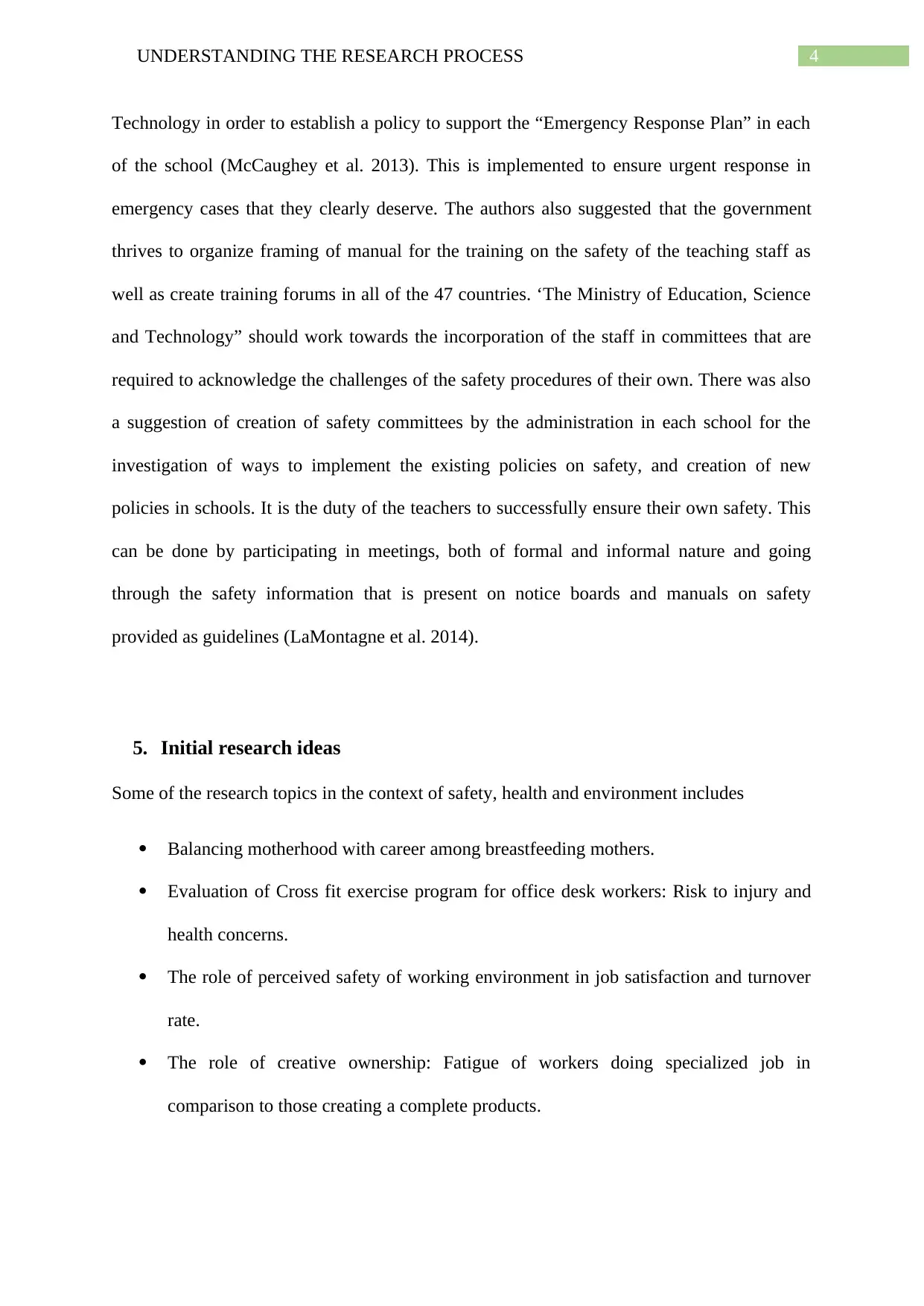
4UNDERSTANDING THE RESEARCH PROCESS
Technology in order to establish a policy to support the “Emergency Response Plan” in each
of the school (McCaughey et al. 2013). This is implemented to ensure urgent response in
emergency cases that they clearly deserve. The authors also suggested that the government
thrives to organize framing of manual for the training on the safety of the teaching staff as
well as create training forums in all of the 47 countries. ‘The Ministry of Education, Science
and Technology” should work towards the incorporation of the staff in committees that are
required to acknowledge the challenges of the safety procedures of their own. There was also
a suggestion of creation of safety committees by the administration in each school for the
investigation of ways to implement the existing policies on safety, and creation of new
policies in schools. It is the duty of the teachers to successfully ensure their own safety. This
can be done by participating in meetings, both of formal and informal nature and going
through the safety information that is present on notice boards and manuals on safety
provided as guidelines (LaMontagne et al. 2014).
5. Initial research ideas
Some of the research topics in the context of safety, health and environment includes
Balancing motherhood with career among breastfeeding mothers.
Evaluation of Cross fit exercise program for office desk workers: Risk to injury and
health concerns.
The role of perceived safety of working environment in job satisfaction and turnover
rate.
The role of creative ownership: Fatigue of workers doing specialized job in
comparison to those creating a complete products.
Technology in order to establish a policy to support the “Emergency Response Plan” in each
of the school (McCaughey et al. 2013). This is implemented to ensure urgent response in
emergency cases that they clearly deserve. The authors also suggested that the government
thrives to organize framing of manual for the training on the safety of the teaching staff as
well as create training forums in all of the 47 countries. ‘The Ministry of Education, Science
and Technology” should work towards the incorporation of the staff in committees that are
required to acknowledge the challenges of the safety procedures of their own. There was also
a suggestion of creation of safety committees by the administration in each school for the
investigation of ways to implement the existing policies on safety, and creation of new
policies in schools. It is the duty of the teachers to successfully ensure their own safety. This
can be done by participating in meetings, both of formal and informal nature and going
through the safety information that is present on notice boards and manuals on safety
provided as guidelines (LaMontagne et al. 2014).
5. Initial research ideas
Some of the research topics in the context of safety, health and environment includes
Balancing motherhood with career among breastfeeding mothers.
Evaluation of Cross fit exercise program for office desk workers: Risk to injury and
health concerns.
The role of perceived safety of working environment in job satisfaction and turnover
rate.
The role of creative ownership: Fatigue of workers doing specialized job in
comparison to those creating a complete products.
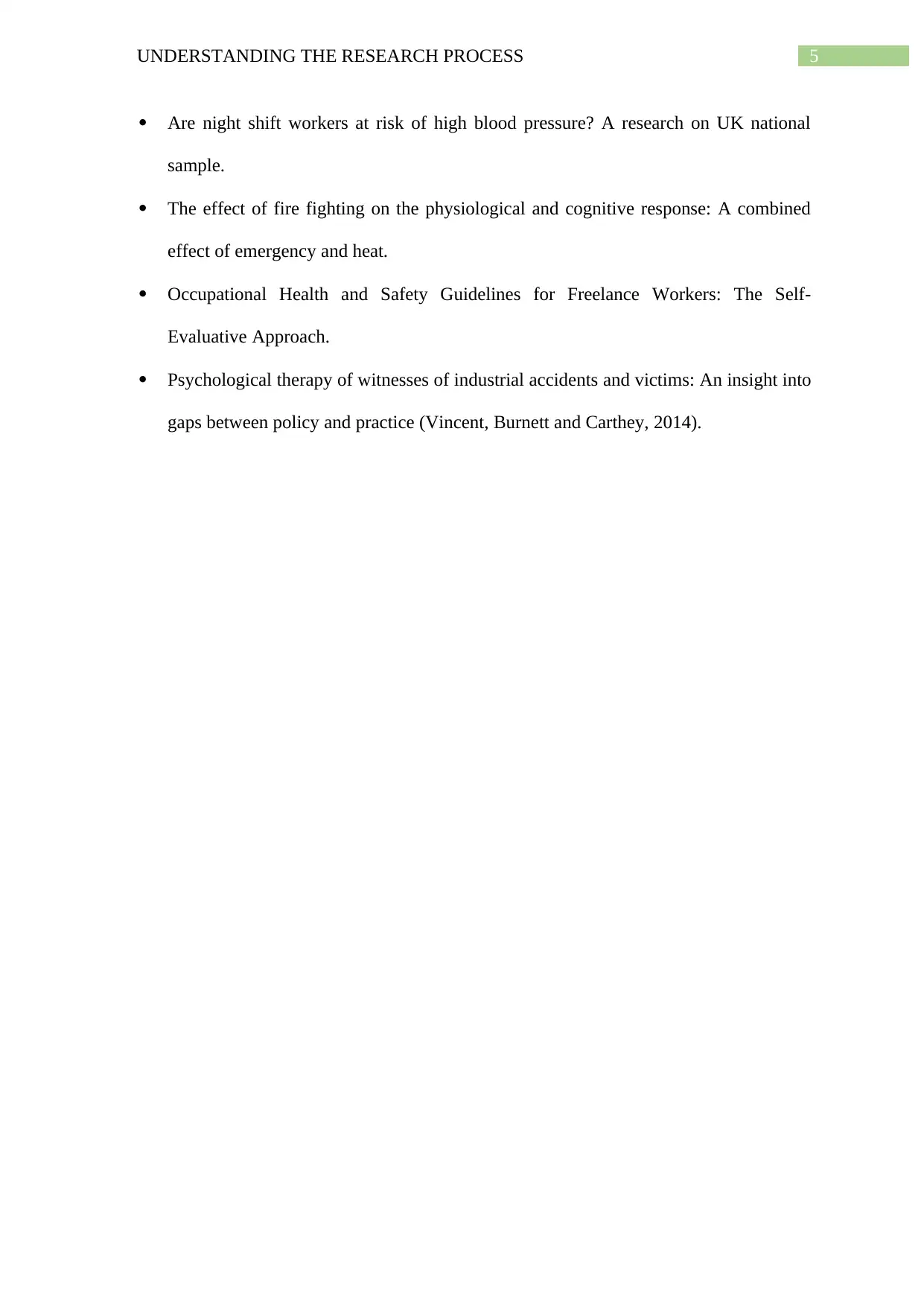
5UNDERSTANDING THE RESEARCH PROCESS
Are night shift workers at risk of high blood pressure? A research on UK national
sample.
The effect of fire fighting on the physiological and cognitive response: A combined
effect of emergency and heat.
Occupational Health and Safety Guidelines for Freelance Workers: The Self-
Evaluative Approach.
Psychological therapy of witnesses of industrial accidents and victims: An insight into
gaps between policy and practice (Vincent, Burnett and Carthey, 2014).
Are night shift workers at risk of high blood pressure? A research on UK national
sample.
The effect of fire fighting on the physiological and cognitive response: A combined
effect of emergency and heat.
Occupational Health and Safety Guidelines for Freelance Workers: The Self-
Evaluative Approach.
Psychological therapy of witnesses of industrial accidents and victims: An insight into
gaps between policy and practice (Vincent, Burnett and Carthey, 2014).
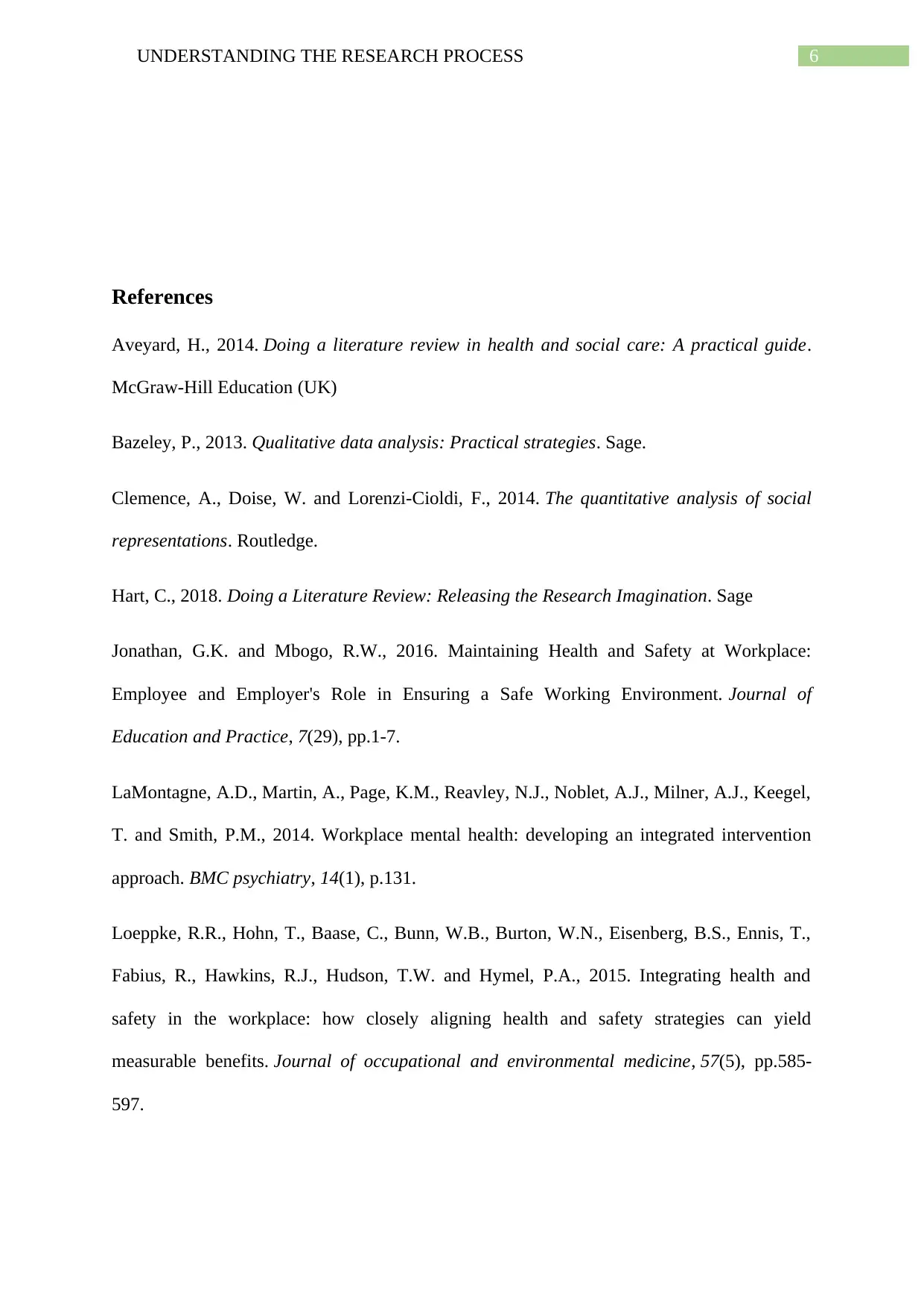
6UNDERSTANDING THE RESEARCH PROCESS
References
Aveyard, H., 2014. Doing a literature review in health and social care: A practical guide.
McGraw-Hill Education (UK)
Bazeley, P., 2013. Qualitative data analysis: Practical strategies. Sage.
Clemence, A., Doise, W. and Lorenzi-Cioldi, F., 2014. The quantitative analysis of social
representations. Routledge.
Hart, C., 2018. Doing a Literature Review: Releasing the Research Imagination. Sage
Jonathan, G.K. and Mbogo, R.W., 2016. Maintaining Health and Safety at Workplace:
Employee and Employer's Role in Ensuring a Safe Working Environment. Journal of
Education and Practice, 7(29), pp.1-7.
LaMontagne, A.D., Martin, A., Page, K.M., Reavley, N.J., Noblet, A.J., Milner, A.J., Keegel,
T. and Smith, P.M., 2014. Workplace mental health: developing an integrated intervention
approach. BMC psychiatry, 14(1), p.131.
Loeppke, R.R., Hohn, T., Baase, C., Bunn, W.B., Burton, W.N., Eisenberg, B.S., Ennis, T.,
Fabius, R., Hawkins, R.J., Hudson, T.W. and Hymel, P.A., 2015. Integrating health and
safety in the workplace: how closely aligning health and safety strategies can yield
measurable benefits. Journal of occupational and environmental medicine, 57(5), pp.585-
597.
References
Aveyard, H., 2014. Doing a literature review in health and social care: A practical guide.
McGraw-Hill Education (UK)
Bazeley, P., 2013. Qualitative data analysis: Practical strategies. Sage.
Clemence, A., Doise, W. and Lorenzi-Cioldi, F., 2014. The quantitative analysis of social
representations. Routledge.
Hart, C., 2018. Doing a Literature Review: Releasing the Research Imagination. Sage
Jonathan, G.K. and Mbogo, R.W., 2016. Maintaining Health and Safety at Workplace:
Employee and Employer's Role in Ensuring a Safe Working Environment. Journal of
Education and Practice, 7(29), pp.1-7.
LaMontagne, A.D., Martin, A., Page, K.M., Reavley, N.J., Noblet, A.J., Milner, A.J., Keegel,
T. and Smith, P.M., 2014. Workplace mental health: developing an integrated intervention
approach. BMC psychiatry, 14(1), p.131.
Loeppke, R.R., Hohn, T., Baase, C., Bunn, W.B., Burton, W.N., Eisenberg, B.S., Ennis, T.,
Fabius, R., Hawkins, R.J., Hudson, T.W. and Hymel, P.A., 2015. Integrating health and
safety in the workplace: how closely aligning health and safety strategies can yield
measurable benefits. Journal of occupational and environmental medicine, 57(5), pp.585-
597.
Paraphrase This Document
Need a fresh take? Get an instant paraphrase of this document with our AI Paraphraser
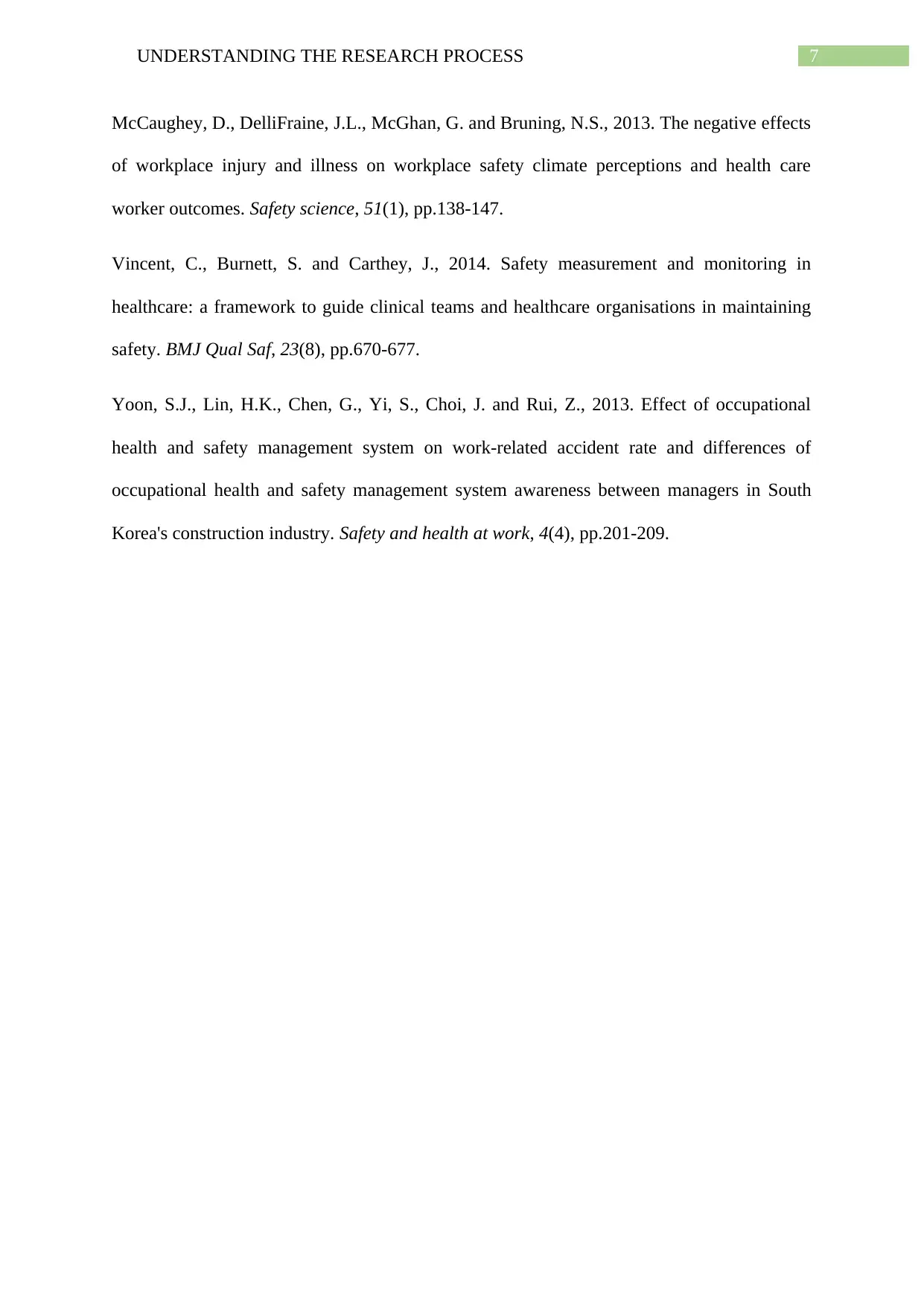
7UNDERSTANDING THE RESEARCH PROCESS
McCaughey, D., DelliFraine, J.L., McGhan, G. and Bruning, N.S., 2013. The negative effects
of workplace injury and illness on workplace safety climate perceptions and health care
worker outcomes. Safety science, 51(1), pp.138-147.
Vincent, C., Burnett, S. and Carthey, J., 2014. Safety measurement and monitoring in
healthcare: a framework to guide clinical teams and healthcare organisations in maintaining
safety. BMJ Qual Saf, 23(8), pp.670-677.
Yoon, S.J., Lin, H.K., Chen, G., Yi, S., Choi, J. and Rui, Z., 2013. Effect of occupational
health and safety management system on work-related accident rate and differences of
occupational health and safety management system awareness between managers in South
Korea's construction industry. Safety and health at work, 4(4), pp.201-209.
McCaughey, D., DelliFraine, J.L., McGhan, G. and Bruning, N.S., 2013. The negative effects
of workplace injury and illness on workplace safety climate perceptions and health care
worker outcomes. Safety science, 51(1), pp.138-147.
Vincent, C., Burnett, S. and Carthey, J., 2014. Safety measurement and monitoring in
healthcare: a framework to guide clinical teams and healthcare organisations in maintaining
safety. BMJ Qual Saf, 23(8), pp.670-677.
Yoon, S.J., Lin, H.K., Chen, G., Yi, S., Choi, J. and Rui, Z., 2013. Effect of occupational
health and safety management system on work-related accident rate and differences of
occupational health and safety management system awareness between managers in South
Korea's construction industry. Safety and health at work, 4(4), pp.201-209.
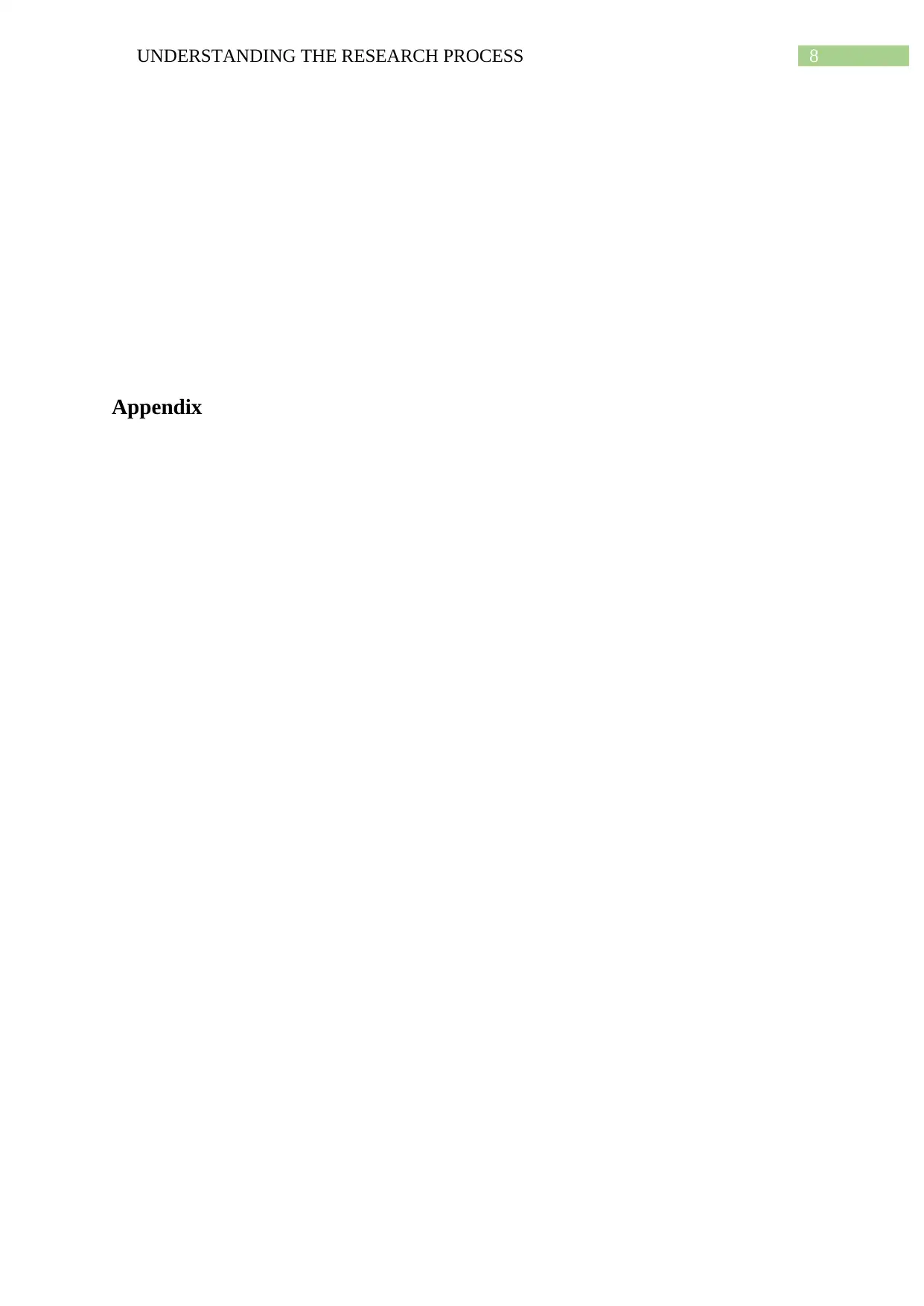
8UNDERSTANDING THE RESEARCH PROCESS
Appendix
Appendix
1 out of 9
Related Documents
Your All-in-One AI-Powered Toolkit for Academic Success.
+13062052269
info@desklib.com
Available 24*7 on WhatsApp / Email
![[object Object]](/_next/static/media/star-bottom.7253800d.svg)
Unlock your academic potential
© 2024 | Zucol Services PVT LTD | All rights reserved.





